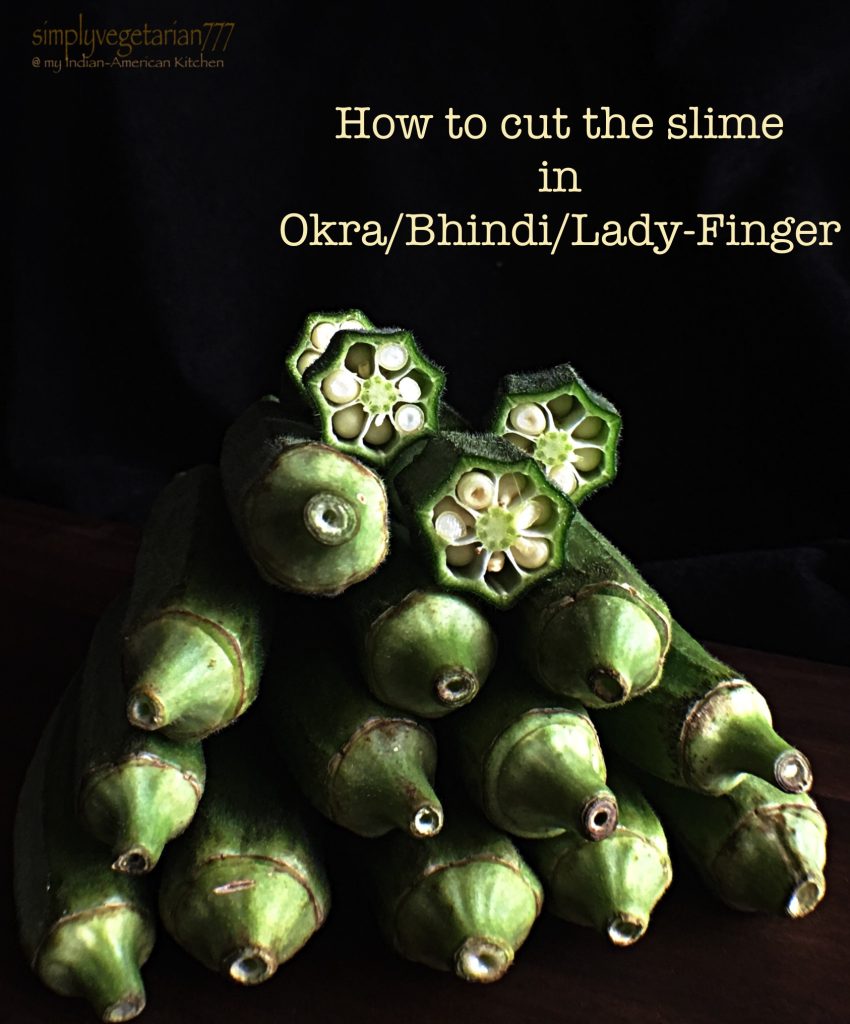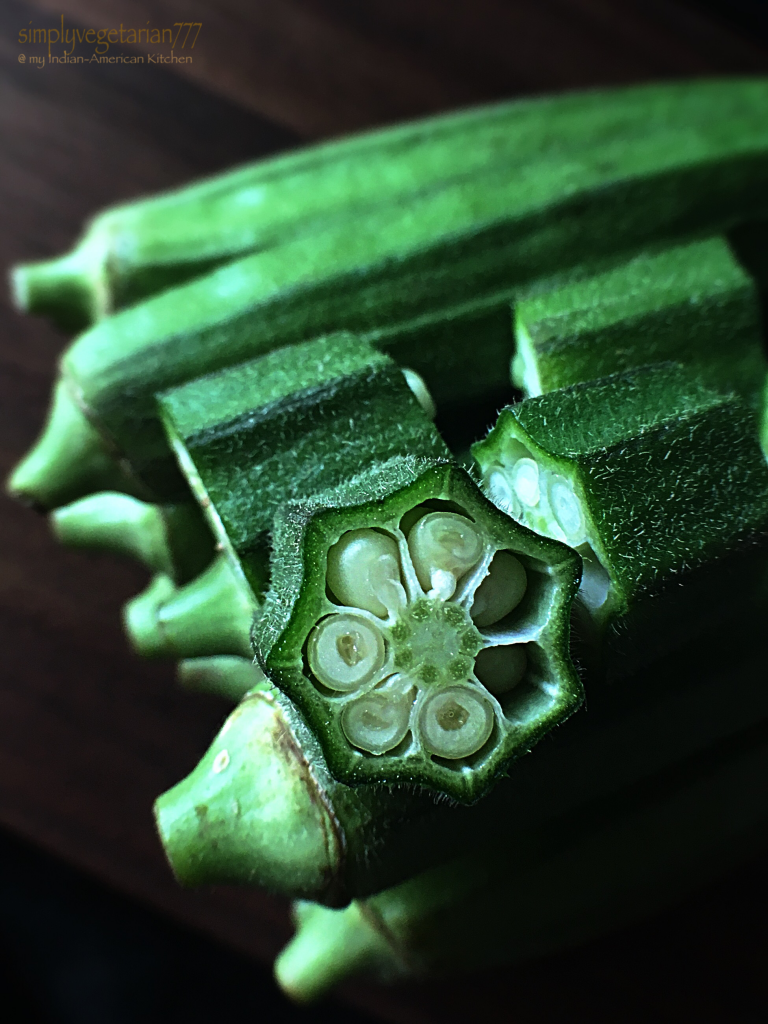How to cut the slime in Bhindi /Okra/ Lady Finger
As an Amazon Associate and member of other affiliate programs, I earn from qualifying purchases.

How to cut the slime in Bhindi /Okra/ Lady Finger

How to cut the slime in Bhindi /Okra/ Lady Finger is the hot and buzzing search word on my blog these days. Isn’t that crazy? I think I know the reason. Earlier, I had tagged few of the Bhindi recipes with the title since I did explain the topic in short in those posts.
How to cut the slime in Bhindi /Okra/ Lady Finger needed to be blogged separately with that kind of demand.
Bhindi is also known as Okra in American English and Lady Finger in Indian & British English. It is a produce that is much used in Indian cuisine, Cajun & Carribean cuisine and Southern American cuisine.
I have seen 2 categories of the people with Bhindi/Okra – one who absolutely love Okra and another, who hate okra. Now there are another 2 categories of the people with okra – one who cook okra effortlessly and another who detest cooking Bhindi.
Ask me why they hate cooking with okra? It is because of its Slimy Nature. The plant and its fruit contain mucilage, which is the same thing you’ll find in aloe vera plants. When you apply heat, the slime just comes out more. But there actually are a few techniques for reducing all that sliminess, that is if you’re willing to give it a try. Believe me, I use few of these techniques myself, depending upon how much time I have in hand.
Here are some recipes that I have blogged so far with BHINDI – Bhindi do Pyaaza , Bharwaa Bhindi, Tawa Fry and Bhindi Masala .

Choosing the Bhindi/Okra
It is always advisable to choose the right kind of okra. Try to pick the smaller Bhindi which looks very green and tender. The brown or blemished okra is of no good. While cutting the okra, the knife should move smoothly without making any noise. If the knife makes any scratchy itchy noise, then discard that okra. It is woody in texture and too fibrous to eat.
Temperature of the “ready to cook” Bhindi/Okra matters
Always use the Bhindi which is at the room temperature. Do not cut the Bhindi / okra immediately after taking out of the refrigerator.
Washing & Drying the Bhindi/Okra
It is very important to wash the okra thoroughly. After washing, it needs to be dried completely before using. Contact with Water triggers more slime. Few methods to drying the Bhindi/Okra –
- You must pat them dry, thoroughly with kitchen towel before cutting/using.
- After washing, leave the okra on kitchen towel to dry on its own for 1-2 hrs. Once completely dry, you may start with the recipe.
- The 2 most effective methods in Indian Cooking that I use and which never disappoint me are – After patting the okra dry, I cut it into the desired shape. If I am running out of time, I place the cut okra in a microwave safe plate (do not overcrowd) and microwave it on high for 5-6 minutes. The slime goes away and okra is cooked wonderfully. With this method, Bhindi gets cooked faster and is really crisp. If I have pre planned on cooking the okra/Bhindi then after cutting, I spread the cut okra/Bhindi out on the kitchen paper towel and let th cut okra dry for good 3-4 hrs before using. The cooked okra is crisp and has no slime.
Type and Size of the Pan used to cook Bhindi/Okra
Always use a heavy bottom pan. A good quality non stick pan or a hard anodized pan (I use it all the time) is a good option too. Make sure that the pan is large to hold all the okra. Do not over crowd the okra while cooking. Over crowding will lead to producing more slime, because it gets steamed under each other then.
Temperature and Method to cook the Bhindi/Okra/Ladyfinger
It is recommended to cook the okra on high heat. Stir often. Grease your cooking pan liberally. Always cook okra in the pan without lid. It doesn’t need any steam formation to soften it.
Using Bhindi in Indian recipes
The Indian cuisine normally uses 2 kinds of cuts in making Sabzi/curry. Either they are cut into thin roundles or they are cut lengthwise into fine longs. Though the experts say to avoid cutting okra too much to avoid the slime, but Indian cooking is an exception. After drying out my cut okra, when I cook it in pan, I use an acid medium to make sure that there is absolutely no slime in the okra. Few ingredients to use as an acid medium are – Amchur/Dry Raw Mango Powder or Lemon or Lime. Many people cook it with tomatoes also for the same reason. I have never cooked tomatoes with Bhindi though.
Using Okra in American recipes
Many American recipes require whole okra, which is actually good since there is no escape of the slime. Still for further precaution, it is advised to precook the whole okra on high heat first in good amount of oil and then use it in Gumbos. Carribean Cooks often squeeze a good amount of lemon while cooking okra to cut the slime. Many of the American methods suggest to dip the whole okra in vinegar to cut the slime out.
Some Nutritional FAQs about Bhindi/Okra/Ladyfinger
It is a beneficial vegetable that contains high amounts of vitamin C, calcium and fiber, Folate and Vitamin K. Not to mention, it’s low in calories.
Okra is known for harnessing a superior fiber, which helps with digestion, stabilizes blood sugar, and helps to control the rate at which sugar is absorbed. Therefore, it is really good for diabetes management.
It is recommended vegetable to be consumed to promote healthy pregnancy.
Even small quantities of okra in diet help in controlling asthama symptoms.
It lowers cholesterol.
It boosts Immune system and also prevents kidney disease.
Do let me know how you eliminate the slime in the okra. More information shared is always beneficial for all.
Sonal

Sonal this is exactly the sort of post I need! I am the sort who likes okra, but only when it isn’t too slimy, and the sliminess generally deters me from cooking with it. I will try the acid next time, as well as precooking it in the microwave! 🙂 Using those methods, I should be able to incorporate it into all sorts of things…!
Thank you so much
One way I learnt to cook okra is that once it is transfered on heavy bottom pan….initial few minutes Ot it should be cooked on high flame in oil. The oil should not be too much or less…then it should be cooked without lid.on slow fire…this way…it does not leave any slime….
Such beautfiul images Sonal and thanks for your very informative post. I’ve just planted okra this week in the garden where I volunteer at. Last year was my first attempt; it was quite funny actually, when the plant produced the fruit, it was really long and imagine my excitement thinking this was a different variety and a great length – but alas I found out the hard way that it should have been harvested when the fruit was about 6″ and not 10″ long LOL Lesson learned, I will know now. But the best part, we let the fruit dry out in the fall, and it made for a very decorative Fall arrangement. Oh and by the way Sonal, I also learned just 2 weeks ago that when you bake okra there is absolutely no slime involved either. Give that a try too. I just drizzled it with olive oil and lemon pepper seasoning, and wow! it was wonderful!
Thanks Loretta!! I am flattered ❤️..
The method that you described sounds really good. Have to try it next time
Excellent tips to avoid slime. Maybe now I can become a better cook with bhindi. Never knew why amchur is used in bhindi, other than fur the tangy taste. Now I know. Thanks.
Thank you
Okra is also very popular in Southern US food as fried okra.
Yes
When you dip slices of okra into cornmeal, then fry them in a little butter and oil, there’s no slime — just a wonderful-tasting mouthful of nutrition. You can also use a basic batter to dip them in, but I’m lazy and just stir the pieces around in a bowl of cornmeal.
That sounds delicious Marilyn